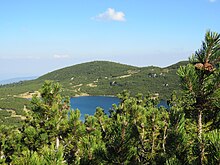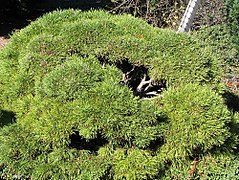Mountain pine
| Mountain pine | ||||||||||||
|---|---|---|---|---|---|---|---|---|---|---|---|---|

Mountain pine ( Pinus mugo ) |
||||||||||||
| Systematics | ||||||||||||
|
||||||||||||
| Scientific name | ||||||||||||
| Pinus mugo | ||||||||||||
| Turra |
The mountain pine ( Pinus mugo ) is a diverse plant species from the genus of the pines ( Pinus ) within the pine family (Pinaceae).
Needles, cones and seeds
The dark green, pointed needles are in pairs on the short shoots and are up to 5 cm long. Their lifespan is 5 to 10 years.
The mountain pine is single sexed ( monoecious ), so there are male and female cones on one individual. The pollen is formed at the base of young long shoots instead of leafy short shoots in the axils of scale leaves.
The hard and egg-shaped female cones are set near the end of young long shoots. They hardly grow longer than 10 mm, are pale pink to red and hardly grow until the first autumn. In the second year they grow and mature; then they release the winged seeds . These are 4 to 5 mm in size. The ovules sit open on scale-shaped carpels, so they are not enclosed in an ovary ( naked seed ).
The seed cones are symmetrical; the spiral has asymmetrical cones. The tenon (if any) is centric and straight, i. H. lying in the pin axis. The shield of the seed scales is mostly flat, seldom slightly arched or conical. The cones are between 3 and 7 cm long. If the cones are open, they reach a width between 2 and 5 cm. The flowering period during the summer months of June and July is followed by seed ripening in October. The fruits develop over a period of three years.
Subspecies
The mountain pine occurs in at least three subspecies and other intermediate forms, which differ particularly in their shape and their occurrence. All three subspecies of the mountain pine have the chromosome number 2n = 24. Other authors have the rank of species.
The subspecies form hybrids : they are thus linked in a hybrid manner, and there are a number of intermediate clans .
Pinus mugo Turra subsp. mugo (mountain pine, laying pine, crippled pine)
Pinus mugo subsp. mugo , even mountain pine , mountain pine , mountain pine , mountain pine , Legkiefer , Zunter , mountain pine or cripple pine called: This subspecies grows mostly shrubby and reaches stature heights of 1 to 3 meter. It is characterized by its crooked growth with prostrate to arching trunks and branches; these often form an impenetrable tangle ( pine felt or pine field ). The trunk of the mountain pine is long, but lies on the ground and is hardly recognizable.
The main occurrences of mountain pine are in the Alps , the Ore Mountains , the Carpathians , as well as the northern Apennines and the mountains of the Balkan Peninsula ( Balkan Mountains , Dinarides , Pirin , Rhodope Mountains ) at altitudes of 1000 to 2700 meters. In Austria , except for Vienna and Burgenland, it is frequently represented in all federal states.
The mountain pine grows mainly in the subalpine Krummholzzone of ocean high mountains and is there associated with alpine roses . In addition, it inhabits moderately dry, rocky, very wet, cold or destructive snow movements ( avalanches ). Mountain pines, like green alder, can even colonize slopes on which avalanches often break out that completely destroy all other tree species. From locations that are more favorable for tree growth, mountain pines are being displaced by more demanding and there more competitive climax tree species, such as the common beech, provided that the natural competitive conditions are not distorted by game browsing, grazing cattle, alpine and forestry or other human activities. As an ornamental wood, it is often planted in gardens, where it thrives better protected from competing tree species (especially competition from light) in human care than in its natural habitat.
Pinus mugo subsp. uncinata (DC.) Domin (Spirke, hooked pine, upright mountain pine)
Pinus mugo subsp. uncinata , also called Spirke , Hooked Pine or Upright Mountain Pine . Some botanists call it a separate species of Pinus uncinata DC. viewed. The Spirke grows tree-shaped and reaches heights of up to 25 meters.
The hooked pine is found in the Pyrenees , the French Massif Central , the Swiss Jura , the western and central Swiss Alps and the northern Alps (e.g. in the Wimbachtal , Friedergries and the Fernpass as Austria's largest spiral forest). In the Jura it inhabits altitudes from 500 to 1700 meters and in the Valais from 900 to 2300 meters. The Spirke sometimes forms extensive pure stands, but also grows in the lower layers in particular with larch , Swiss stone pine and Scots pine .
Pinus mugo subsp. rotundata (Link) Janch. & H.Neumayer (Moorspirke)
Pinus mugo subsp. rotundata , also called bog mountain pine or bog spirke , is in habitus between the mountain pine and the spirke. Depending on the location, it resembles the leg pine with prostrate branches without a recognizable main trunk or, as an upright, often multi-stemmed tree with a growth height of 8 to 10 meters, the hook pine.
It occurs in the Vosges, the Black Forest, the Alpine Foreland , the Bavarian Forest , South Bohemia, the Fichtel and Ore Mountains and in the Lausitz . The Moor-Spirke is a wood of the montane level and grows mainly at heights between 800 and 1200 meters. In the Allgäu Alps, it rises on the Windecksattel at Gottesacker to an altitude of up to 1750 meters.
ecology
In northern locations, if the snow cover is too long, the mountain pine is very damaged by the fungus Herpotrichia nigra ( black snow mold ) (blackish, glued tufts of needles).
The elastic branches are adapted to the winter snow pressure of the high altitudes.
Wood
The wood of the mountain pine is hard and difficult to split, i. that is, it has good transverse strength and is not very elastic. Due to its resin content, it gives off a resin odor. It has a reddish core that darkens when exposed to light and a sapwood that is 2 to 4 cm wide and yellowish-white. Also typical are the soapy surface and relatively large branches of dark brown color.
use
The use of the wood is similar to that of the Scots pine . Since the trunks and branches are not very thick, they can at best be used as wood turners and carved wood, as well as for simple furniture, as planed goods in interior and exterior construction and in window construction. Freshly cut, however, the sapwood is very susceptible to bluish fungus.
Mountain pine oil for cosmetic products is obtained from fresh needles, twig tips and branches . In the distillery , the oil is obtained by means of steam distillation. As a finished mountain pine oil, it can be bottled naturally and offered for sale. It is used both externally and internally for catarrh of the upper and lower respiratory tract. In medicinal baths it is used for the supportive treatment of diseases of the rheumatic type in the non-acute stage.
Selection grades
Some varieties have been selected (selection):
- Pinus mugo (mountain pine) - broad, conical growth, 4–5 m high, versatile, also for privacy protection
- Pinus mugo 'Alpenzwerg' - conical, compact, slow growth, up to 1.5 m high, for troughs and small gardens
- Pinus mugo 'Carsten' - compact, up to 3 m high and 6 m wide, needles are yellow to light green
- Pinus mugo 'Gnom' - densely branched, upright and slowly growing form, up to 3 m high and up to 2 m wide, needles densely packed, dark green
- Pinus mugo 'Henry' - decidedly dwarf and slow growth, dense and spherical, up to 40 cm high and 50 cm wide, very short distances between the branches, annual growth only 1 to 3 cm, for the smallest of spaces
- Pinus mugo 'Humpy' - broad, pillow-shaped, dense growth, up to 30 cm high and 100 cm wide, very short, densely packed, gray-green needles, for small spaces
- Pinus mugo 'Mops' - spherical growth, up to 1.5 m high, slowly growing, needles are dark green, well suited for troughs,
- Pinus mugo 'Mini Mops' - dwarf form, flat, up to 50 cm high and 1 m wide, very slow growing
- Pinus mugo mughus (laying pine) - less strong, but growing wider than Pinus mugo, 2–3 m high and wide, for covering and as a low privacy screen
- Pinus mugo pumilio (creeping pine) - dense and slow growth, also wide and prostrate, up to 80 cm high and 150 cm wide, for small spaces
- Pinus mugo 'Wintergold' - broad, bushy growth, up to 80 cm high and 120 cm wide, needles light yellow in summer and a beautiful golden yellow in winter.
Pinus mugo subsp. uncinata , Spirke as an atypical "natural bonsai ".
swell
- Christopher J. Earle, 2017: Description and classification Pinus mugo s. st. at The Gymnosperm Database . (English)
literature
- Johanna Graßmann, Renate Spitzenberger, Susanne Hippeli, Renate Vollmann, Erich F. Elstner: Essential oils from mountain pine . Scientific review. 55 (3) 2005, ISSN 0028-1050 , pp. 127-133.
- Wolfgang Adler, Karl Oswald, Raimund Fischer: Excursion flora of Austria. Ed .: Manfred A. Fischer . Ulmer, Stuttgart / Vienna 1994, ISBN 3-8001-3461-6 .
- Ulrich Hecker: Trees and Bushes. 2nd edition, blv, Munich 2012, ISBN 978-3-8354-0941-5 .
Individual evidence
- ^ Erich Oberdorfer : Plant-sociological excursion flora for Germany and neighboring areas . With the collaboration of Angelika Schwabe and Theo Müller. 8th, heavily revised and expanded edition. Eugen Ulmer, Stuttgart (Hohenheim) 2001, ISBN 3-8001-3131-5 , pp. 94-95 .
- ↑ Christopher J. Earle, 2017: Description and systematics Pinus mugo s. st. at The Gymnosperm Database . (English)
- ↑ Pinus mugo Turra s. str., Krummholz pine. In: FloraWeb.de.
- ^ E. von Raab-Straube, 2014: Gymnospermae. Data sheet Pinus uncinata In: Euro + Med Plantbase - the information resource for Euro-Mediterranean plant diversity .
- ↑ Pinus uncinata DC. s. st., hook-jaw. In: FloraWeb.de.
- ↑ Pinus rotundata Link, bog pine. In: FloraWeb.de.
- ↑ Erhard Dörr, Wolfgang Lippert : Flora of the Allgäu and its surroundings. Volume 1, IHW, Eching 2001, ISBN 3-930167-50-6 , p. 109.
Web links
- Pinus mugo in the endangered Red List species the IUCN 2006. Posted by: Conifer Specialist Group, 1998. Retrieved on 9 May, 2006.
- Pinus mugo subsp. mugo. In: FloraWeb.de.
- Pinus mugo agg., Mountain pine (species group). In: FloraWeb.de.
- Mountain pine . In: BiolFlor, the database of biological-ecological characteristics of the flora of Germany.
- Profile and distribution map for Bavaria . In: Botanical Information Hub of Bavaria .
- Pinus mugo Turra s. l. In: Info Flora , the national data and information center for Swiss flora .
- Thomas Meyer: Data sheet with identification key and photos at Flora-de: Flora von Deutschland (old name of the website: Flowers in Swabia ).














